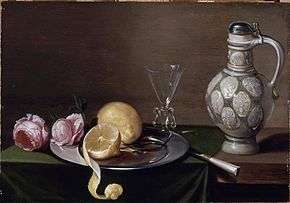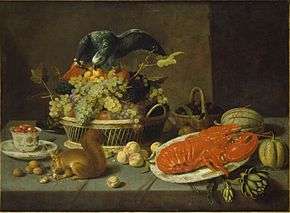Jacob Foppens van Es

Jacob Foppens van Es or Jacob Fopsen van Es[1] (c. 1596, probably in Antwerp – 1666 in Antwerp) was a Flemish Baroque painter who was known for his still lifes mainly of food and occasionally flower paintings. He collaborated with other artists on garland paintings.
Life
Biographical data about Foppens van Es’ life are scarce. He was probably born in Antwerp as can be concluded from the text on a portrait of Foppens van Es engraved by Wenceslaus Hollar.[2] In 1617 he became a master of the Antwerp Guild of St. Luke in 1617 but only became a full master in 1645.[2] His pupils included Jacob Gillis in 1621 and Jan van Tienen in 1623.

His success as an artists is testified by evidence that his works were in many 17th century Antwerp collections. Even the inventory of the leading Flemish Baroque painter Peter Paul Rubens included two of his works.[2] Further proof of his success is that his portrait made by Joannes Meyssens and engraved by Wenceslaus Hollar was included in the collection of artist portraits entitled Images de Divers Hommes Despirit Sublime qui par leur art et science debvrovent vivre eternellement et des quels la louange et renomée facit estonner le monde, published in Antwerp in 1649, with the following text:
- IACOBVS VAN ES/ Peinctre Excellent en fruicts poissons oiseauz et fleurs les/ quelles il faict extremement bien au naturel il demeure a Anvers/ y estant ne.[3]
(Translation: Jacobus van Es, painter who excels in fruit, fish, birds and flowers which he renders very well naturally he lives in Antwerp where he was born)
Jacob Foppens van Es was friends with leading Antwerp artists such as Jacob Jordaens, Cornelis Schut en Deodat del Monte who were godfathers to his children.[2]
He was buried in Antwerp on 11 March 1666.[4]
Works
General

Jacob Foppens van Es painted mainly still lifes and in particular still lifes of food. They typically depict fruit, fish, lobster, oysters, mussels, cheese, ham, bread, olives, lemons and oranges together with objects such as glassware, pitchers and silver. Occasionally his compositions include animals such as butterflies, birds or squirrels or a flower. His still lifes typically depict a random accumulation of unrelated objects on a sharply inclined table with the principal concern being the realisation of rich colour.[5]
His still lifes are generally archaizing in style and follow the small 'breakfast still lifes' of the Flemish masters Osias Beert and Clara Peeters. He later came under the influence of the Dutch still life painter Floris van Schooten. His works achieve a sense of three-dimensionality through dramatic lighting and a wide range of colours.[2]
Flower pieces
He also produced some flower pieces which are of an exceptional simplicity, use original colour combinations and a powerful technique. An example is the Vase with Flowers (Fondation Custodia, Paris). This composition is of a charming simplicity with its three roses and an iris placed in an earthenware jug on a wooden table.[2]
Garland paintings

Foppens van Es occasionally worked on garland paintings in which the staffage was painted by other artists. Garland paintings are a special type of still life developed in Antwerp by Jan Brueghel the Elder and Hendrick van Balen at the request of the Italian cardinal Federico Borromeo at the beginning of the 17th century.[6][7] Other artists involved in the early development of the genre included Andries Daniels, Peter Paul Rubens and Daniel Seghers. The genre was initially connected to the visual imagery of the Counter-Reformation movement.[6] It was further inspired by the cult of veneration and devotion to Mary prevalent at the Habsburg court (then the rulers over the Southern Netherlands) and in Antwerp generally.[6][7] Garland paintings typically show a flower garland around a devotional image, portrait or other religious symbol (such as the host).[7]
An example of a collaboration by Foppens van Es on a garland painting is A garland of flowers and fruit with a central cartouche depicting the Holy Family (Musée des Beaux-Arts d'Orléans) (c. 1620-1630). Hendrick van Balen is believed to have painted the cartouche while Foppens van Es painted the garland of fruit and flowers.[8]
References
- ↑ Many more name variations including: Jacob van Es, Jacob Fossens van Essen (I), Jacob Fossen van Essen, Jacob Fobsen (van Essen), Jaques Foppsen, Iaces van Ees, Jacob Fobsen van Es
- 1 2 3 4 5 6 Christine van Mulders. "Es, Jacob van." Grove Art Online. Oxford Art Online. Oxford University Press. Web. 27 February 2015
- ↑ The Wenceslaus Hollar Digital Collection, University of Toronto.
- ↑ Jacob Foppens van Es at the Netherlands Institute for Art History (Dutch)
- ↑ Hans Vlieghe, Flemish Art and Architecture, 1585-1700, Pelican history of art. New Haven: Yale University Press, 1998
- 1 2 3 David Freedberg, "The Origins and Rise of the Flemish Madonnas in Flower Garlands, Decoration and Devotion", Münchener Jahrbuch der bildenden Kunst, xxxii, 1981, pp. 115–150.
- 1 2 3 Susan Merriam, Seventeenth-Century Flemish Garland Paintings. Still Life, Vision and the Devotional Image, Ashgate Publishing, Ltd., 2012
- ↑ A garland of flowers and fruit with a central cartouche depicting the Holy Family at the Netherlands Institute for Art History
| Wikimedia Commons has media related to Jacob Foppens van Es. |